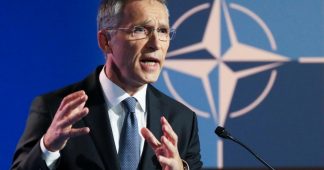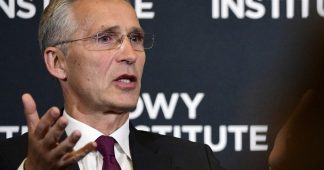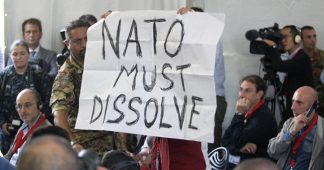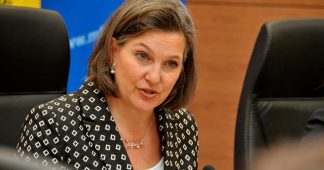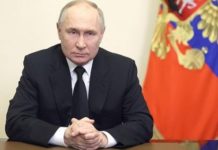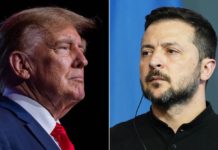Rules-based international order: NATO, Goldman Sachs and the Council on Foreign Relations
Rick Rozoff
Mar.13, 2021
North Atlantic Treaty Organization Secretary General Jens Stoltenberg had a busy week in the U.S., though he didn’t visit the institutions or meet with the personnel traditionally engaged by the head of history’s longest and largest military bloc. He didn’t, for example, interact with the Pentagon, the NATO Allied Command Transformation headquarters in Norfolk, Virginia, the State Department or the White House. Instead, in a revealing indication of where NATO understands substantive foreign policy decisions to be deliberated over and agreed upon, he addressed a university-based elite international affairs think tank, the Goldman Sachs investment bank and financial services company and America’s preeminent global affairs think tank, the Council on Foreign Relations.
From the most recent backwards, on March 11 Stoltenberg delivered the David A. Morse Lecture at the Council on Foreign Relations with Admiral James Stavridis, formerly NATO Supreme Allied Commander Europe and now with the Carlyle Group, moderating. The NATO website reported his insisting “NATO must strengthen collective defence, step up transatlantic consultations, and stand up for the international rules based order – which he warned ‘is being challenged by authoritarian powers, including China.’”
NATO’s definition of the rules-based international order and its plans for China will be examined later.
He also, as though it was in his nature to refrain from doing so, condemned “Russia’s use of diverse tools such as cyber-attacks and disinformation on social media to interfere with Allied democracies and political processes.”
On March 10 Stoltenberg was guest of honor at the Talks at GS [Goldman Sachs] forum with John Waldron, president and chief operating officer of The Goldman Sachs Group. He didn’t waste much time before evoking NATO’s Article 5 collective war clause, which in 2001 was employed to deploy military forces to Afghanistan and later Kyrgyzstan, Pakistan, Tajikistan and Uzbekistan, and conduct under Operation Active Endeavor the naval surveillance and interdiction of the entire Mediterranean Sea. He affirmed that “our core task is to protect and defend each other,” and that, correspondingly, if “one Ally is attacked that will be regarded as an attack on the whole Alliance.” That is as stark a military threat as can be made in the nuclear age and it’s aimed squarely at Russia.
He also spoke of the almost twenty-year war in Afghanistan, where NATO troops now outnumber American ones by four times, 10,000 to 2,500, and Iraq where NATO recently announced it would have twice as many troops as the U.S., 5,000 compared to 2,500.
Although acknowledging that “The Soviet Union and the Warsaw Pact was [sic] the main reason for NATO’s existence for decades,” despite the fact that both were dissolved thirty years ago NATO has gone from sixteen members and no partners to thirty members and forty partners in the interim, with members and partners on all inhabited continents. Stoltenberg didn’t address the obvious contradiction, nor did Goldman Sachs ask him about it. Global expeditionary NATO suits its concerns entirely. Though by way of both candor and no little vainglory, he said this about the process: “There were actually some people talking about the possibility of Russia joining NATO because we had all the members….the Warsaw Pact – there were eight members to the Warsaw Pact, the Soviet Union, Poland, Eastern Germany, Romania and these central and eastern European countries. Out of those eight countries, seven are today a member of NATO. And the eighth, the Soviet Union, doesn’t exist. But three former republics in the Soviet Union, the Baltic countries, are member[s] of NATO….”
He went on to identify 2014 as the watershed year in which Russia went from a partner to an adversary, and itemized how NATO has pushed the military advance toward Russia in a detailed manner: “[T]hings have really changed and especially in 2014, when Russia used military force to annex a part of another country, Crimea in Ukraine. And we see a more assertive Russia. We see Russia investing heavily in new military capabilities, new nuclear weapons, new advanced delivery systems and of course that’s the reason also why NATO has implemented the biggest reinforcement to our collective defence since the end of the Cold War, with combat ready battlegroups in the eastern part of the Alliance – we didn’t have that before, we have it now, higher readiness of our forces, increased defence spending – after years of cutting defence spending, all Allies have started to increase defence spending, and also changed our command structure and implemented really big changes of this Alliance since 2014.”
Surely someone in Russia must realize that, just as in 1812 and 1941, massive multinational military forces aren’t deployed along its entire western border with any other intent but to intimidate and ultimately attack the country.
His indictment of Russia, the precise sort of litany of accusations ordinarily used to justify a military attack, continued:
“But then, this is not only about military. Because what we see is that Russia is using a wide range of tools. Military tools, as they have done for instance in Syria or in Libya or against Ukraine, but they use economic tools and they use cyber and political tools, and they try to meddle in our domestic political processes. We have seen that in the United States. We have seen it in other European countries. We have seen many reports about cyberattacks.”
Truly, any adversary that nefariously, that comprehensively, that incorrigibly hostile and threatening must be neutralized. And that is what NATO is bent on achieving.
Once Russia is disposed of NATO will contend with China. In fact it’s already begun to do so. Stoltenberg had this to say on the topic:
“China is an authoritarian regime, they don’t share our values, they don’t pretend that they share our democratic values. They believe in another set of principles and values, and it will be the first time actually in centuries that the biggest economy in the world doesn’t share our liberal democratic values.”
At the NATO defense ministers meeting in February Stoltenberg said that “China and Russia are at the forefront of an authoritarian pushback against rules-based international order.”
This is a good time to discuss the expression rules-based international order as it’s employed on most every occasion by NATO of late. Variants of its are values-based international order and liberal international order. Much like the term a Europe whole and free (or a Europe whole, free and at peace) introduced by President George H. W. Bush in Mainz, Germany in 1989, it’s an example of a codeword, catchphrase, countersign, shibboleth routinely exchanged by Atlanticist and broader globalist elites but which the general public in their respective countries have never heard of.
It has to be understood that what is meant as the rules-based international order is distinct from and frequently openly opposed to international law, the United Nations Charter, treaties and traditional norms. practices and precedents in many cases going back centuries, in the case of Europe to the end of the Thirty Years’ War in 1648.
An excerpt from a presentation at the Royal Institute for International Affairs (Chatham House) in London in 2015 entitled Challenges to the Rules-Based International Order offers a concise and unequivocal illustration of what the NATO chief means when he speaks of threats to the rules-based international order:
“The danger today is that this questioning of US global leadership has opened the space for other countries to pursue a ‘might is right’ approach to their own policy priorities. Russia has annexed Crimea in violation of commitments to the Budapest Memorandum, has intervened directly in the conflict in Ukraine, and has laid out a doctrine that brazenly demands recognition of a Russian sphere of influence around its neighbourhood. [emphasis added – RR] The Chinese leadership is taking steps to turn its contested claims over islands in the South China and East China seas into a fait accompli. And regional powers in the Middle East, concerned about the current and future US administrations responding to the post-Iraq experience by being more selective in their support for traditional allies, are taking the preservation of their security into their own hands. The question arises, therefore, whether the post-Second World War institutions and rules can survive these challenges to US global leadership.”
U.S. global leadership that includes control of international financial institutions and the Internet as well as assigning the entire surface of the earth to six regional military commands and six naval fleets.
In the same year then-U.S ambassador to Germany John Emerson presented an address to the 14th Berlin Security Conference: Euro-Atlantic Partnership entitled The Importance of a Rules-Based International Order, which contained these words:
“We have spent a lot of time today discussing the threat of terrorism, the crisis in Ukraine, and the war in Syria, but let me give you three aspects of our collective security interests that we must also address. They are cyber stability, climate control, and trade and investment.”
In this week’s presentations at Goldman Sachs, the Council on Foreign Relations and the Center for International Security and Cooperation at Stanford University, Stoltenberg repeatedly mentioned cyber security and climate control and occasionally world trade and financial matters. He addressed Goldman Sachs after all.
On March 9 he spoke at the Center for International Security and Cooperation where he was hosted by Rose Gottemoeller, former Deputy Secretary General of NATO during the Barack Obama and Donald Trump administrations and also Under Secretary of State for Arms Control and International Security at the U.S. State Department, and by Michael McFaul, U.S. ambassador to Russia from 2012-2014 and currently a professor at the International Studies in the Department of Political Science at Stanford University.
There he could hardly contain his enthusiasm for someone who has been militantly pro-NATO to a degree and for a length of time, in both intensity and duration arguably uncontested in the world currently, effusing: “[O]n the Biden administration, I really welcome the very strong commitment and a very strong message from a President Biden and from his whole security team, the message on strengthening alliances, strengthening NATO. And I have had the privilege of working with President Biden in his previous capacities as Vice President, but also as the chairman of the Senate Foreign Relations Committee. And I know that he knows NATO and he knows Europe. And he really understands the importance of NATO bringing North America and Europe together.”
Specifically he applauded the Biden administration’s decision to rescind his predecessor’s pledge to withdraw a third of American troops stationed in Germany.
He also celebrated the deployment of NATO’s first surveillance drones in Sigonella in Italy, which the government of South Ossetia revealed had been deployed along its and Russia’s southern border almost immediately. And he praised NATO as “the only institution where North America and Europe meets [sic] every day.”
While touting NATO’s 2030 initiative he emphasized its role in preparing a new Strategic Concept to replace that adopted at the bloc’s summit in Lisbon, Portugal in 2010 because “the world has changed,” and “in the current Concept, we refer to Russia, where we say that we are aspiring for a strategic partnership with Russia.” But that “was before Ukraine, before Crimea and before the much more assertive behaviour of aggressive actions by Russia over the last years and especially since 2014.”
Similarly. he said that “the rise of China really is defining for the transatlantic relationship and NATO has to address the rise of China.” It would seem rather incumbent on China to address the rise of global NATO as the latter counts as military partners Asia-Pacific nations like Australia, Japan, South Korea, Mongolia, Afghanistan, Pakistan, Kazakhstan, Kyrgyzstan, Tajikistan, Turkmenistan, Uzbekistan and New Zealand, six of which border China.
Further regarding China, and by extension the world, he said: China is “now the second largest defence spender in the world, soon the biggest economy, the challenge China represents to the rules-based order, to our core values of democracy, that we have a big power, China, not sharing our values, all of that makes it necessary for NATO to remain a regional alliance, but to respond to the global challenge that the rise of China represents.”
To the point he added: “NATO should respond in many different ways. Partly, we should work more closely with our partners in the Asia-Pacific: Australia, New Zealand, Japan, South Korea and potentially also others.”
Again, no challenges to the rules-based international order will be tolerated.
And as for Russia:
“We have to understand that we have implemented the biggest reinforcement of our collective defence in a generation, since the end of the Cold War, with the battlegroups in the eastern part of the Alliance, something we never had before, combat-ready battlegroups in Poland and the Baltic countries, tripled the size of the NATO response force, higher readiness of our forces, and increased investments in defence, 190 billion extra across Europe and Canada just since 2014. Part of that adaptation is also new command structures for the Atlantic, the vital link between Europe and North America and in Europe, in Germany. Then, on the Black Sea, well, that has been part of our adaptation, that we also have increased our presence in the Black Sea, with air policing, with more naval presence. Just the last few couple of months we have seen several US naval ships sailing in the Black Sea. All the NATO Allies have operated there with naval and air assets.
“And we have also established what we call a tailored forward presence in Romania. And we are working not only, of course, we have three littoral states, Bulgaria, Romania and Turkey, but also two very close partners, Georgia and Ukraine, and we are working closely with them. So we have also the Enhanced Air Policing in the region. And all of this is part of NATO’s response to a more assertive Russia. Let me just add briefly that by saying that we are delivering credible deterrence and defence, because we see Russia responsible for aggressive actions against Ukraine, increased military presence in North Africa and elsewhere in the Middle East.”
Regarding both Russia and China, NATO’s activities at the top of the world were outlined by its secretary general as follows:
“Five NATO Allies are actually Arctic countries and much of NATO territory and NATO waters are in the Arctic. And therefore, NATO is present in the Arctic. And as part of the broader adaptation of our Alliance over the last years, we have increased our presence in the Arctic, meaning with more naval presence, more air presence. We have NATO Allies, but also including the United States, operating more in the Arctic.
“And we, of course, realise the increasing strategic importance of the Arctic, partly caused by global warming, because less ice, more open sea, and partly because of the increased Russian presence in the Arctic.”
The preservation and all-inclusive expansion of the post-World War II, post-Cold War U.S.-engineered rules-based international order is now NATO’s main mission. It is preparing final mopping-up operations after having dispensed with holdouts like Yugoslavia, Iraq, Afghanistan, Libya, Syria, Macedonia, Slovakia, Ivory Coast and others. The remaining recalcitrants, however, are in at least three instances nuclear powers.
Published at antibellum679354512.wordpress.com
